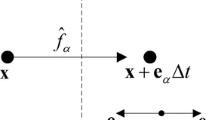Abstract
The homotopy analysis method (HAM), as a new mathematical tool, has been employed to solve many nonlinear problems. As a fundamental equation in non-equilibrium statistical mechanics, the Boltzmann integro-differential equation (BE) describing the movement of particles is of strong nonlinearity. In this work, HAM is preliminarily applied to dilute granular flow which is relatively simple. By choosing the Maxwell velocity distribution function as the initial solution, the concrete expression of the first-order approximate solution to BE with collision term being the BGK model is given. Furthermore it is consistent with the solution using Chapman-Enskog method but does not rely on little parameters.
Similar content being viewed by others
References
Campbell C S. Granular material flows: An overview. Powder Tech, 2006, 162: 208–229
Campbell C S. Stress controlled elastic granular shear flows. J Fluid Mech, 2005, 539: 273–297
Wang G Q, Xiong G, Fang H W. The general constitutive relation of particle flow (in Chinese). Sci China Ser E (Chinese Ver), 1998, 28: 282–288
Wang G Q, Ni J R, Fei J X. The kinetic model for collisional stresses in rapid granular flows. Chin J Theor Appl Mech, 1993, 25: 348–355
Jop P, Forterre Y, Pouliquen O. A constitutive law for dense granular flows. Nature, 2006, 441: 727–730
Sun Q C, Wang G Q. Introduction of Particle Mechanics (in Chinese). Beijing: Science Press, 2009
Ge W, Li J H. Macro-scale pseudo-particle modeling for particle-fluid systems. Chinese Sci Bull, 2001, 46: 1503–1506
Li J H. Nonlinearity and computer simulation of particle-fluid systems (in Chinese). Chinese Sci Bull (Chinese Ver), 1996, 41(S1): 10
Wang G Q. The motion theory and experimental study of solid-liquid two-phase flows and granular flows (in Chinese). PhD Dissertation. Beijing: Tsinghua University, 1989
Chapman S, Cowling T G. The Mathematical Theory of Non-uniform Gases. Cambridge: Cambridge University Press, 1970
Wang G Q, Hu C H. Research Development of Sediment (in Chinese). Beijing: China Waterpower Press, 2006
Fu X D, Wang G Q. Kinetic model of particle phase in dilute solid-liquid two-phase flows (in Chinese). Chin J Theor Appl Mech, 2003, 35: 650–659
Ying T C. The Theory and Application of Gas Transportation (in Chinese). Beijing: Tsinghua University Press, 1990
Cercignani C. The Boltzmann Equation and its Applications. New York: Springer-Verlag, 1988
Chen W F, Wu Q F. Methods for solving Boltzmann equation (in Chinese). J Nat Univ Defense Tech, 1999, 21: 4–7
Huang Z Q, Ding E J. A kind of singular perturbation method for solving the Boltzmann equation with small Knudsen number (in Chinese). Acta Phys Sin, 1984, 33: 722–727
Huang Z Q, Ding E J. The singular perturbation solution of Boltzmann equation I— normal solution (in Chinese). Acta Phys Sin, 1985, 34: 65–76
Huang Z Q, Ding E J. The singular perturbation solution of Boltzmann equation II— initial layer solution (in Chinese). Acta Phys Sin, 1985, 34: 77–87
Huang Z Q, Ding E J. The singular perturbation solution of Boltzmann equation III— boundary layer solution (in Chinese). Acta Phys Sin, 1985, 34: 213–224
Huang Z Q, Ding E J. The singular perturbation solution of Boltzmann equation IV— extension to non-Maxwell molecules (in Chinese). Acta Phys Sin, 1985, 34: 225–234
Huang Z Q, Ding E J. Theory and applications of the Boltzmann equation (in Chinese). Prog Phys, 1986, 6: 300–351
Wei J B, Zhang X W. Eternal solutions of the Boltzmann equation (in Chinese). Acta Math Sci, 2007, 27: 240–247
Kawashima S, Asano K. Global solution of the initial value problem for a discrete velocity model of the Boltzmann equation. Proc Japan Acad, 1981, 57: 19–24
Peirano E, Leckner B. Fundamentals of turbulent gas-solid flows applied to circulating fluidized bed combustion. Prog Energy Combust Sci, 1998, 24: 259–296
Shen H C. Exact solution of the Boltzmann equation (in Chinese). Appl Math Mech, 1987, 8: 419–431
Liu T P, Yang T. Energy method for Boltzmann equation. Physica D, 2004, 188: 178–192
Wang G Q, Ni J R. Research review of particle flows (in Chinese). Mech Eng, 1992, 14: 7–19
Xuan Y M, Li Q, Yao Z P. Application of lattice Boltzmann scheme to nanofluids. Sci China Ser E, 2004, 47: 129–140
Huang W F, Li Y, Liu Q S. Application of the lattice Boltzmann method to electrohydrodynamics: Deformation and instability of liquid drops in electrostatic fields. Chinese Sci Bull, 2007, 52: 3319–3324
Liao S J. Beyond Perturbation: Introduction to the Homotopy Analysis Method (in Chinese). Beijing: Science Press, 2006
Sajid M, Hayat T. Comparison between the HAM and HPM solutions of thin film flows of non-Newtonian fluids on a moving belt. Nonlin Dyn, 2007, 50: 27–35
Abbasbandy S. The application of homotopy analysis method to solve a generalized Hirota-Satsuma coupled KdV equation. Phys Lett A, 2007, 361: 478–483
Tan Y, Abbasbandy S. Homotopy analysis method for quadratic Riccati differential equation. Comm Nonlin Sci Numer Simul, 2008, 13: 539–546
Gidaspow D, Ding J M, Jayaswal U K. Multiphase Navier-Stokes equation solver-numerical methods for multiphase flows. ASME, 1990, 91: 47–56
Wang G Q, Ni J R. The kinetic theory for dilute solid/liquid two-phase flow. Int J Multiph Flow, 1991, 17: 273–281
Wang G Q, Ni J R. Kinetic theory for particle concentration distribution in two-phase flow. J Eng Mech, 1990, 116: 2738–2748
Author information
Authors and Affiliations
Corresponding author
Additional information
Supported by the National Basic Research Program of China (Grant No. 2007CB714101) and Research Fund of the State Key Laboratory for Hydroscience and Engineering in Tsinghua University (Grant No. 2008-ZY-6)
About this article
Cite this article
Zhang, L., Wang, G., Fu, X. et al. An analytical solution to Boltzmann equation of dilute granular flow with homotopy analysis method. Chin. Sci. Bull. 54, 4365–4370 (2009). https://doi.org/10.1007/s11434-009-0701-6
Received:
Accepted:
Published:
Issue Date:
DOI: https://doi.org/10.1007/s11434-009-0701-6




